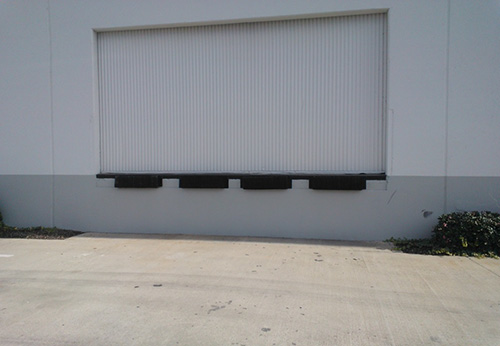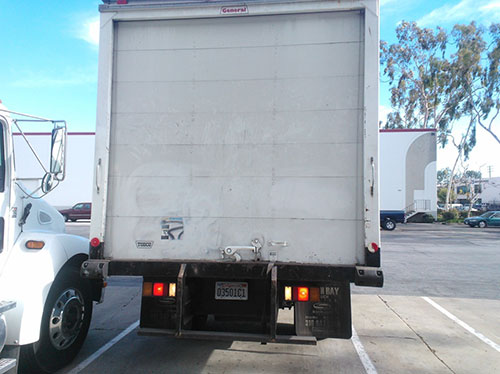Case Report: 12CA009
Day laborer dies when he is pinned between a loading dock and backing truck
Download a PDF to print this report:
Day laborer dies when he is pinned between a loading dock and backing truck (12CA009, PDF)
Summary
A day laborer died when he was pinned between a loading dock and a backing truck. The victim was hired while standing in front of a home and garden store. His job was to load and unload trucks at a warehouse. He was attempting to climb up on a loading dock as a truck was backing up and was pinned between the two. The truck had rear-view mirrors on both sides of the truck as well as a working audible back-up alarm. The driver did not see the victim because he was in the truck’s blind spot. The contributing factor identified in this investigation was a worker in the backing zone of a truck with a blind spot. The CA/FACE investigator determined that in order to prevent future incidents, employers with loading docks should:
- Ensure that administrative procedures or engineering devices are in place to assist drivers of backing trucks.
In addition, employers who hire day laborers should:
- Ensure they receive safety training and are competent in the work they are hired to perform.
Introduction
On Thursday, August 30, 2012, at approximately 11:30 a.m., a 30-year-old male Hispanic day laborer died when pinned between a loading dock and a backing truck. The CA/FACE investigator received notification of this incident on September 19, 2012, from the Bureau of Investigations of the Division of Occupational Safety and Health (Cal/OSHA). On November 16, 2012, the CA/FACE investigator went to the incident site to take pictures and interviewed the manager of the warehouse and the other warehouse worker. Copies of the coroner’s report and police report were also obtained.
Employer
The employer of the victim was a beverage distribution company that had been in business for three years and had nine employees.
Written Safety Programs and Training
The beverage company did not have any safety or training programs for their employees. Of the nine employees, one was the victim, one was a truck driver, one was a warehouse worker, and the other six were sales and office personnel.
Worker Information
The victim was a Hispanic male day laborer from Guatemala who had completed an undergraduate degree. He had been in the United States for six years and spoke only Spanish. He was hired by the truck driver of the beverage company to replace the regular warehouse worker who was unable to work because of illness. The incident occurred on the victim’s second day of employment at this company.
Incident Scene
The incident scene was a loading dock at a warehouse behind a series of corporate buildings.
Weather
The weather on the day and time of the incident was clear and sunny and a temperature of 84°F.
Investigation
On the day of the incident, the victim was standing on the loading dock waiting for the truck to back up to be unloaded. As the truck started backing up to the warehouse dock, the victim jumped down off the dock to throw some trash into a dumpster. The victim's supervisor was on the dock watching the backing truck and did not stop the driver when the victim jumped off the dock. The supervisor stated that at the last second, the victim attempted to climb back up on the dock and was pinned between the dock and the truck. The supervisor yelled for the truck driver to pull forward. The truck driver said that he was aware of people working in the warehouse but saw no one in his rear-view mirrors on the ground when he started backing. He said he heard his back-up alarm working and when he made contact with the dock, he heard someone yell to him to pull forward. The truck driver pulled forward and the victim took a couple of steps then collapsed. The paramedics were called and they pronounced the victim dead at the scene.
Contributing Factors
Occupational injuries and fatalities are often the result of one or more contributing factors or key events in a larger sequence of events that ultimately result in an injury or fatality. The CA/FACE investigator identified the worker in the backing zone of a truck with a blind spot as a contributing factor in this investigation:
Cause of Death
The cause of death according to the death certificate was multiple traumatic injuries.
Recommendations
Recommendation #1: Ensure that administrative procedures or engineering devices are in place to assist drivers of backing trucks.
Discussion: In this incident, the victim was in the blind spot of the backing truck. The truck had the proper mirrors as well as a functioning back-up alarm; however there was still a blind spot directly behind the truck where the driver could not see. This was the area the victim placed himself as the truck was backing. The supervisor was observing the operation but didn't stop the truck driver when the victim jumped off the dock and entered the backing zone. In order to prevent these types of incidents from recurring, employers should consider the following options:
- Install concave mirrors on the dock for drivers of backing trucks to see objects or individuals within their blind spots.
- Install other engineering controls on loading docks such as motion detectors, strobe lights, or gates which restrict access.
- Assign an employee as a spotter in clear view of the driver to direct the backing truck and to alert the driver whenever an obstruction occurs within the blind spot.
- Prohibit all foot traffic in the work area.
- Retrofit all trucks with cameras for the drivers to see their blind spots when backing.
Had any of these options been in place, this incident could have been prevented.
In addition, employers who hire day laborers should:
Recommendation #2: Ensure they receive safety training and are competent in the work they are hired to perform.
Discussion: In this incident, the employer had their truck driver hire a day laborer to perform warehouse work until the regular warehouse worker, who was unable to work because of a sickness, was able to return. The truck driver stated that he hired the victim standing outside a home and garden store in the area. Because the truck driver was the only one who spoke the victim's language, he told him that the work he was being hired for was to unload and load beverage trucks at the warehouse dock. No safety training or other instructions were given to the victim.
Day laborers are workers who meet at well-known locations, usually public street corners or commercial parking lots, and wait for building contractors, landscapers, home owners, and other potential employers to offer work. Day laborers include immigrants from Mexico, South America and Central America who are unable to gain formal employment because of their legal status. Day laborers are often willing to work regardless of potential hazards that may be present on the job site and may not be aware of or able to notify their employers if they are concerned about their working conditions. Most day laborers have received little, if any, safety training in the work they are hired to perform.
Employers who hire day laborers to perform various work tasks must provide a safe and healthy work environment and ensure that they are capable of understanding and performing all of the safety aspects related to their work. Employers are responsible for ensuring that jobsite-specific training is provided to all employees, in a language and literacy level they can understand, including day laborers. Additional training may be provided by organizations that offer workplace safety training to day laborers, such as the Construction Safety Council (CSC), La Raza Centro Legal Program in San Francisco, the City of Los Angeles Day Laborer Centers, Instituto de Educación Popular Del Sur de California (IDEPSCA), and the National Day Laborer Organizing Network (NDLON). Day laborers who have undergone such training are more likely to be familiar with and implement safe work practices.
Exhibits

Exhibit 1. A truck loading dock identical to the one involved in the incident. Trucks back up to the dock in order to load and unload product.

Exhibit 2. The rear of a truck similar to the one involved in this incident.
References
Division of Occupational Safety and Health -Title 8 regulations -Subchapter 4 Construction Safety Orders Article 10 Haulage and Earth Moving §1592 (b) Warning Methods.
On the Corner: Day Labor in the United States - report
CDL Driver Guide to Best Practices for Safe Backing
Authors
Hank Cierpich, FACE Investigator
Robert Harrison, MD, MPH, FACE Project Officer
Laura Styles, MPH, Research Scientist
October 15, 2013